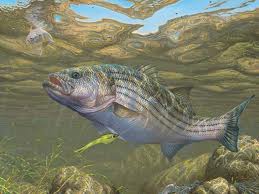Striped Bass on the Fly, Part 2
In his book, LL Bean Fly Fishing for Striped Bass Handbook, Lyons Press, New York, 1998, author
Brad Burns discusses the feeding habits of striped bass:
“I once read a report on a population of striped bass that lived in a Canadian estuary
on the Northumberland shore. Examining the stomach contents of the bass revealed to Canadian fisheries scientists that these
stripers ate virtually every living creature that resided with them in the river. This incredible versatility as feeders,
of course, requires that the fish be equally versatile as hunters. And it is this versatility that makes the striped bass
such a superb fly-rod target.”
“When
stripers are feeding on the surface or in shallow water, their presence is detectable by the splashes or swirls that they
make. Even at night, the feeding pops and splashes of hungry bass can be heard from some distance. Their surface swirls along
a shallow beach are often clearly visible. Once you have located feeding stripers, you can settle into imitating whatever
bait they’re chasing.”
The
striper’s preferred food is soft-rayed finfish like smelt or herring species such as gaspereau and shad. They are easier
to catch than a rapid swimmer like mackerel and swim in large schools. Their soft fins and bodies make them easy to swallow,
and their fat, oily bodies are highly nutritious and possess five times the caloric count of a lean fish like cod. Other finfish
enjoyed by stripers are silversides and sand eels. Stripers also feed on sandworms, squid, and crustaceans like shrimp and
crabs. All of these species inhabit Nova Scotia waters, so we should carry flies that imitate them. As noted earlier, versatility
is important.
Sometimes stripers are opportunistic
and will hit anything that moves near them. To me, this signals a great chance to use surface popper flies that bring those
exciting, explosive takes we love. At other times they can be very selective, especially as to the size, action and depth
of the fly.
Although surface fishing with
floating lines may be the most enjoyable way to catch stripers, the depth at which they are feeding may dictate use of sinking
or sink tip lines for successful fly fishing. When fish are feeding at a depth of 12 feet, for example,
surface fishing just doesn’t work. Next, we can vary fly size. Finally, we can vary the fly’s speed and action
as we strip the fly. Notice that fly color has not even been mentioned, but there’s a saying based upon striper’s
color perception studies, “What’s the use if it ain’t chartreuse?” Nonetheless, fly color seems less
important than the other attributes. Most baitfish have a dark back and light sides & belly, so that’s a good model
to use in our fly designs.
I recall
my fly fishing for stripers failing miserably one May weekend, while my fishing partner, Jim McCoul, caught several trolling
rubbery plastic springy things. Striper schools in the muddy Stewiacke tidewater were huge, so many as to audibly hit the
bottom of our aluminum boat at times. On our second fishing day, when I stopped being a purist and tied one of these silly
looking affairs to my fly leader, I too began catching fish. Since I had been fishing flies that matched the color and size
of the lures, at the correct speed and depth, this experience demonstrated how selective striped bass can be. The lure’s
action may have been transmitting vibrations that accounted for its success. Perhaps a fly fitted with tiny rattles (these
are available) would have succeeded in attracting fish in the muddy water. Another option would be to employ Eumer Monster
cones on tube flies, causing them to wobble like Rapala lures. Fly fishers can also appeal to the striper’s sense of
smell, and I recall a few wily old anglers dousing their salmon flies in sardine oil for this purpose. I suspect that the
techniques of appealing to the senses of sound and smell for all species of sportfish will become more popular in future.
After all, most of our flies are stealthy and smell like moth balls!
Recently an angler mentioned that some 3 – 4 lb stripers had been caught recently
in the estuary of Salmon River, Guysborough County. He was concerned that they could become a threat to that system’s
anadromous brown trout and Atlantic salmon, especially juvenile fish. Apart from being an interesting comment on the quality
of fishing we are fortunate to enjoy in Guysborough County (who needs striped bass?), it’s no secret that striper populations
around Nova Scotia and elsewhere have dramatically increased their numbers in recent years. However, since the striper’s
autumn southward migration has likely started, we can hope that these fish at Salmon River are just passing through. Time
will tell.
Next week we’ll look
at some striper flies.
Please
stay on the line …
